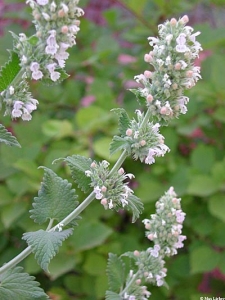Catnip and Catmint — What’s the Difference?
By Elaine Homstad, Fairfax Master Gardener
Novice gardeners often disregard botanical names. They just pick up something at the nursery, home improvement store or big-box discount store that bears the common name of a plant they think they want. Such is the case with catnip. True catnip is a perennial herb whose botanical name is Nepeta cataria.

Catmint Nepata faassenii Walker’s Low
Characteristics of Nepeta cataria
N. cataria has square, hairy stalks (like all members of the mint family) and gray-green heart-shaped leaves with scalloped edges. It has rather small and unremarkable white flower spikes, often appearing only late in the season. N. cataria grows to about 30 inches high, has a spreading habit, and can be rather weedy looking, with a tendency to crowd out other plants around it. But this is the variety that appeals to most cats, so if you are growing it for your feline friends, be certain you get this variety.
Characteristics of Nepeta
The genus Nepeta is a member of the mint family (Lamiaceae), of which there are approximately 250 species. Many Nepetas besides N. cataria are called catnip, but they really should bear the common name of catmint. These are the varieties that are most commonly sold, and they actually perform better in the garden as a flowering perennial than does “true” catnip.

Nepeta cataria blossom
A very desirable trait of all Nepetas is that they are generally NOT attractive to deer and rabbits because of their strong fragrance and fuzzy stems and leaves. And they do attract pollinators and other wildlife, such as bees, butterflies and hummingbirds.
Catmint varieties
Most Nepetas that you will find for sale are varieties of N. x faassinii, N. racemosa or N. subsessilis.
Faassen’s catmint (Nepeta x faassenii)
A very easy-to-find variety. Its flowers are sterile flowers, which eliminates the need for deadheading to prevent self-seeding. Cultivars of this species are widely available, including
‘Dropmore’ — 18 inches tall, 36 inches wide, lavender-blue flowers
‘Joanna Reed’ — 24 inches tall, 48 inches wide, lavender-blue flowers
‘Snowflake’ — 12 inches tall, 12 inches wide, white flowers
‘Six Hills Giant’ — 30 inches tall, 48 inches wide, lavender-blue flowers
Persian catmint (Nepeta racemosa)
‘Blue Wonder’ — 18 inches tall, 38 inches wide, lavender-blue flowers
‘Little Titch’ — 10 inches tall, 30 inches wide, purple-blue flowers
‘Walker’s Low’ — 30 inches tall, 36 inches wide, lavender-blue flowers
Japanese catmint (Nepeta subsessilis)
‘Candy Cat’ — 14 inches tall, 27 inches wide, light violet flowers
‘Sweet Dreams’ — 30 inches tall, 36 inches wide, pink flowers

Nepeta x faassenii
Growing catnip and catmints
Most Nepetas can thrive in full sun or partial shade and well-drained but not overly fertile soil. They prefer some benign neglect and do not require fertilizers and rich soil. Once established, they are also both drought-tolerant (as are most plants with gray-green foliage) and humidity-tolerant, making them ideal for local DC-area growing conditions. One caution, however: although they tolerate humidity, they can be susceptible to powdery mildew if overcrowded. They are relatively pest-free, but they can be attractive to aphids, spider mites and slugs. Also, overwatering or excessively moist or poorly drained soil can lead to root rot and death.
Catmints have a mounding tendency and can be easily divided every three to four years. Shearing back plants by about one third after their first blooms fade will encourage a second round of flowers in late summer.
Catmints and catnip can be successfully grown in containers, so if you want to grow true catnip (N. cataria), that is probably a better way to do it — if you can keep your housecat away from it once the plant is indoors.
Fun facts about catnip and cats
- Catnip contains a chemical compound called nepetalactone that triggers a response in the brains of susceptible cats.
- Not all felines are affected by catnip, but even large cats (lions, tigers, leopards, panthers) can be. Experts estimate about 50 to 75 percent have a reaction, which is due to a genetically inherited trait. Very young kittens (under two or three months) and senior cats are less likely to react.
- The effects of catnip on felines varies depending on whether they eat it or only smell it.
- The effect of catnip only lasts 15 to 30 minutes.
- Catnip is not addictive.
- Fresh catnip is a very effective pest repellent against flies, mosquitoes, cockroaches, termites, mice and rats. It is about 10 times as effective as DEET. Unfortunately, when applied to the skin, nepetalactone loses its ability to repel insects.
- Catnip is used by humans as a tea or infusion, as a mild analgesic or sedative, or topically for cuts by crushing and moistening fresh catnip leaves and applying the paste to the wound. Some also use it as an herb for cooking.
Resources
• Herb Culture and Use, VCE Publication 426-420
• A Comparative Study of Cultivated Catmints, Richard G. Hawke, Chicago Botanic Garden Issue 29,
2007
• Pet Nutrition and Animal Wellness, Dr. Joseph Mercola
• Growing Guide: Catmint, Cornell University
• Cool Catmints, Dr. Leonard Perry, University of Vermont Extension